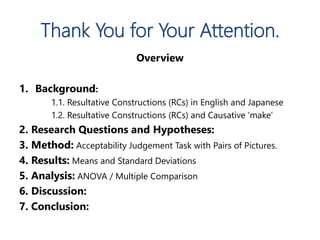BAAL2015
- 1. Obstacles to the acceptability of English resultative constructions by Japanese EFL learners and their over-acceptance of the causative ĄŪmakeĄŊ Yohei HIRANO (Graduate School, Hiroshima University) <yy-mop-1745@hiroshima-u.ac.jp> BAAL Annual Meeting 2015 14:00-14:30, September 3 (Thu) Aston University
- 2. Overview 1. Background: 1.1. Resultative Constructions (RCs) in English and Japanese 1.2. Resultative Constructions (RCs) and Causative ĄŪmakeĄŊ 2. Research Questions and Hypotheses: 3. Method: Acceptability Judgement Task with Pairs of Pictures. 4. Results: Means and Standard Deviations 5. Analysis: ANOVA / Multiple Comparison 6. Discussion: 7. Conclusion: ? Two Steps || ĒŲ3 types of RCs Ąý ĒÚ6 types of RCs
- 3. 1. Background: English Resultative Construction John painted the wall black. S + V + O + ĄķRPĄ· || ĄķResultative PredicateĄ· Washio (1997) argues that resultative constructions can be classified into (at least) two types: ĒŲ Weak Resultatives: Verbs do entail some change of state. ĒÚ Strong Resultatives: Verbs do not entail any change of state or any result.
- 4. 1. Background: Weak Resultative Constructions in English and Japanese (1) English ?John crushed the can flat. ?Mike painted the wall black. Japanese ?John-wa kan-wo petyanko-ni tubusi-ta. John-TOP can-ACC flat crush-PAST ?Mike-wa kabe-wo kuroku nut-ta Mike-TOP wall-ACC black paint-PAST Change-of-State Verbs
- 5. 1. Background: Strong Resultative Constructions in English and Japanese (2)-A English (Transitive Type) ?John hammered the can flat. Japanese ???/*John-wa kan-wo petyanko-ni tatai-ta. John-TOP can-ACC flat pound-PAST (2)-B English (Intransitive Type) ?Ken ran his shoes ragged. Japanese ?*Ken-wa kutu-wo boroboro-ni hasit-ta Ken-TOP shoes-ACC ragged run-PAST Manners / Causes Change of State Characteristics of a satellite-framed language Talmy (2000)
- 6. 1. Background: English Resultative Constructions and Paraphrased Expressions with Causative ĄŪmakeĄŊ English Resultative Constructions (1) Weak John crushed the can flat. Mike painted the wall black. (2)-A Strong-Transitive John hammered the can (flat). (2)-B Strong-Intransitive Ken ran *(his shoes) *(ragged). Paraphrased expressions with causative ĄŪmakeĄŊ (3) John made the can flat by crushing it. Mike made the wall black by painting it. (4)-A John made the can flat by hammering it. (4)-B Ken made his shoes ragged by running.
- 7. 1. Background: English Expressions with Causative ĄŪmakeĄŊ and their Japanese translations (3) English ?John made the glass into pieces by breaking it. ?Mike made the wall black by painting it. Japanese ?John-wa kan-wo tubusi-te petyanko-ni sita. John-TOP can-ACC crush-by flat make-PAST ?Mike-wa kabe-wo nut-te kuroku sita. Mike-TOP wall-ACC paint-by black make-PAST
- 8. 1. Background: English Expressions with Causative ĄŪmakeĄŊ and their Japanese translations (4)-A English ?John made the can flat by hammering it. Japanese ?John-wa kan-wo tatai-te petyanko-ni sita. John-TOP can-ACC pound-by flat make-PAST (4)-B English ?Ken made his shoes ragged by running. Japanese ?Ken-wa hasit-te kutu-wo boroboro-ni sita. Ken-TOP run-by shoes-ACC ragged make-PAST
- 9. 2. Research Questions & Hypotheses RQ1: Do the characteristics of the main verbs have any influence on the acceptability of English resultative constructions by Japanese EFL learners? ?Change-of-State Verbs or not ?Transitive or Intransitive RQ2: Do Japanese EFL learners accept English expressions with causative ĄŪmakeĄŊ more easily than English resultative constructions?
- 10. 2. Research Questions & Hypotheses Hypothesis I: Japanese EFL learnersĄŊ acceptability of (1) is higher than that of (2)-A and that of (2)-B. Hypothesis II: Japanese EFL learnersĄŊ acceptability of (2)-A is higher than that of (2)-B. Hypothesis III: Japanese EFL learnersĄŊ acceptability of (3), (4)-A, and (4)-B is higher than that of (1), (2)-A, and (2)-B, respectively.
- 11. 1. Background: English Resultative Constructions and Paraphrased Expressions with Causative ĄŪmakeĄŊ English Resultative Constructions (1) Weak John crushed the can flat. Mike painted the wall black. (2)-A Strong-Transitive John hammered the can (flat). (2)-B Strong-Intransitive Ken ran *(his shoes) *(ragged). Paraphrased expressions with causative ĄŪmakeĄŊ (3) John made the can flat by crushing it. Mike made the wall black by painting it. (4)-A John made the can flat by hammering it. (4)-B Ken made his shoes ragged by running. Hypothesis IHypothesis IIHypothesis III
- 12. 3. Method: Participants ?Japanese EFL learners: (n=28) ĄēFreshman university students majoring English educationĄģ ĄēEnglish proficiency: TOEIC score 475-860 (Ave. 641.79)Ąģ ?English native speakers: (n=10) ĄēFaculty members of national university AĄģ (n=3) ĄēFaculty members of prefectural university BĄģ (n=6) ĄēGraduate school student of national university AĄģ (n=1)
- 13. 3. Method: Acceptability Judgement Task with Pairs of Illustrations (A)Ken crushed the can. As a result, (B)the can became flat. Ken can
- 14. 3. Method: Acceptability Judgement Task with Pairs of Illustrations completely unnatural fairly unnatural slightly unnatural unableto decide slightly natural fairly natural completely natural Ąû ĻD ĻD ĻD ĻD ĻD ĻD ĻD ĻD ĻD ĻD ĻD ĻD ĻD ĻD ĻD ĻD ĻD ĻD Ąú (-3) (-2) (-1) (0) (+1) (+2) (+3) 1. Ken crushed the can flat. 2. Ken made the can flat by crushing it. 3. Ken crushed and made the can flat. 4. The can became flat by KenĄŊs crushing it. 5. The can was crushed flat by Ken. 6. The can was made flat by crushing it by Ken. Participants responded on a 7 point scale ((-3)~(+3)) to what degree each sentence sounds natural as a description of a series of situations described by the underlined parts (A) and (B).
- 15. APPENDIX: Test Sentences Included in the Task John broke the glass into pieces. Bob bent the wire into a U shape. Mary melted the butter into liquid. Mike tore the letter into pieces. Mike painted the wall black. Ken crushed the can flat. Lucy polished the mirror clean. Kumi froze the juice solid. (1): Weak Resultatives
- 16. APPENDIX: Test Sentences Included in the Task John hammered the can flat. Paul kicked the door open. John knocked Mike unconscious. Tom shot the man dead. Miki watered the tulips flat. Mike shook his father awake. The horse dragged the logs smooth. The earthquake shook the old house into pieces. (2)-A: Strong Resultatives [Transitive]
- 17. APPENDIX: Test Sentences Included in the Task Sam sang himself hoarse. Ken ran himself tired. Takashi ate himself sick. Lucy danced herself sweaty. Ken ran his shoes ragged. Mike shouted his father awake. Lucy danced her feet sore. Tim drank the teapot empty. (2)-B: Strong Resultatives [Intransitive]
- 18. APPENDIX: Test Sentences Included in the Task John made the glass into pieces by breaking it. Bob made the wire into a U shape by bending it. Mary made the butter into liquid by melting it. Mike made the letter into pieces by tearing it. Mike made the wall black by painting it. Ken made the can flat by crushing it. Lucy made the mirror clean by polishing it. Kumi made the juice solid by freezing it. (3): Paraphrased Expressions of (1) with causative ĄŪmakeĄŊ
- 19. APPENDIX: Test Sentences Included in the Task John made the can flat by hammering it. Paul made the door open by kicking it. John made Mike unconscious by knocking him. Tom made the man dead by shooting him. Miki made the tulips flat by watering them. Mike made his father awake by shaking him. The horse made the logs smooth by dragging them. The earthquake made the old house into pieces by shaking it. (4)-A: Paraphrased Expressions of (2)-A with causative ĄŪmakeĄŊ
- 20. APPENDIX: Test Sentences Included in the Task Sam made himself hoarse by singing. Ken made himself tired by running. Takashi made himself sick by eating. Lucy made herself sweaty by dancing. Ken made his shoes ragged by running. Mike made his father awake by shouting. Lucy made her feet sore by dancing. Tim made the teapot empty by drinking. (4)-B: Paraphrased Expressions of (2)-B with causative ĄŪmakeĄŊ
- 21. 3. Methods: Note Whether a verb is a Ą°Change-of-State VerbĄą or not Levin (1993) The main verbs included in the task. Weak Resultatives break, bend, crush, freeze, melt, paint, polish, tear Strong Resultatives (Transitive) drag, hammer, kick, knock, shake, shoot, water (Intransitive) dance, drink, eat, sing, run, shout
- 22. 4. Results: Means and Standard Deviations (1) Weak (2)-A Strong ĄēTĄģ (2)-B Strong (I) (3) (1)-make (4)-A (2)-A-make (4)-B (2)-B-make JLE (n=28) Mean Mean Mean Mean Mean Mean 0.54 -1.45 -2.18 1.48 1.38 1.31 S.D. S.D. S.D. S.D. S.D. S.D. 0.89 0.94 0.92 0.66 0.76 0.67 NSE (n=10) Mean Mean Mean Mean Mean Mean 2.25 1.84 1.04 0.76 -0.45 1.12 S.D. S.D. S.D. S.D. S.D. S.D. 0.65 0.77 1.07 1.01 1.00 0.82
- 23. 4. Results: Means and Standard Deviations 0.54 -1.45 -2.18 1.48 1.38 1.31 2.25 1.84 1.04 0.76 -0.45 1.12 -3 -2 -1 0 1 2 3 (1) (2)-A (2)-B (3) (4)-A (4)-B
- 24. 5. Analysis: Two-way ANOVA Test ? One between-subject factor (Language) [2 levels: Japanese?English] ? One within-subject factor (Sentence Type) [6 levels: (1)?(2)-A?(2)-B?(3)?(4)-A?(4)-B] ?Significant Effect of Language: F(1, 36) = 26.242, ĶĮ2 = .062, p<.001 ?Significant Effect of Sentence Type: F(2.09, 75.39) = 29.741, ĶĮ2 = .141, p<.001 ?Significant Interaction b/w Language and Sentence Type: F(2.09, 75.39) = 60.55, ĶĮ2 = .287, p<.001
- 25. 5. Analysis: Multiple Comparison Test JLE (n=28) (1) > (2)-A (1) > (2)-B (2)-A > (2)-B (p=.000) (p=.000) (p=.000) (3) = (4)-A (3) = (4)-B (4)-A = (4)-B (p=.205) (p=.108) (p=.561) (1) < (3) (2)-A < (4)-A (2)-B < (4)-B (p=.000) (p=.000) (p=.000) NSE (n=10) (1) = (2)-A (1) = (2)-B (2)-A = (2)-B (p=.089) (p=.059) (p=.083) (3) > (4)-A (3) = (4)-B (4)-A < (4)-B (p=.000) (p=.056) (p=.000) (1) > (3) (2)-A > (4)-A (2)-B = (4)-B (p=.000) (p=.000) (p=.850) Verification of Hypotheses I & II
- 26. 2. Research Questions & Hypotheses Hypothesis I: Japanese EFL learnersĄŊ acceptability of (1) is higher than that of (2)-A and that of (2)-B. Hypothesis II: Japanese EFL learnersĄŊ acceptability of (2)-A is higher than that of (2)-B. Hypothesis III: Japanese EFL learnersĄŊ acceptability of (3), (4)-A, (4)-B is higher than that of (1), (2)-A, (2)-B, respectively. ? Supported ? Supported
- 27. 5. Analysis: Multiple Comparison Test JLE (n=28) (1) > (2)-A (1) > (2)-B (2)-A > (2)-B (p=.000) (p=.000) (p=.000) (3) = (4)-A (3) = (4)-B (4)-A = (4)-B (p=.205) (p=.108) (p=.561) (1) < (3) (2)-A < (4)-A (2)-B < (4)-B (p=.000) (p=.000) (p=.000) NSE (n=10) (1) = (2)-A (1) = (2)-B (2)-A = (2)-B (p=.089) (p=.059) (p=.083) (3) > (4)-A (3) = (4)-B (4)-A < (4)-B (p=.000) (p=.056) (p=.000) (1) > (3) (2)-A > (4)-A (2)-B = (4)-B (p=.000) (p=.000) (p=.850) Verification of Hypothesis III
- 28. 2. Research Questions & Hypotheses Hypothesis I: Japanese EFL learnersĄŊ acceptability of (1) is higher than that of (2)-A and that of (2)-B. Hypothesis II: Japanese EFL learnersĄŊ acceptability of (2)-A is higher than that of (2)-B. Hypothesis III: Japanese EFL learnersĄŊ acceptability of (3), (4)-A, (4)-B is higher than that of (1), (2)-A, (2)-B, respectively. ? Supported ? Supported ? Supported
- 29. 5. Analysis: Multiple Comparison Test JLE (n=28) (1) > (2)-A (1) > (2)-B (2)-A > (2)-B (p=.000) (p=.000) (p=.000) (3) = (4)-A (3) = (4)-B (4)-A = (4)-B (p=.205) (p=.108) (p=.561) (1) < (3) (2)-A < (4)-A (2)-B < (4)-B (p=.000) (p=.000) (p=.000) NSE (n=10) (1) = (2)-A (1) = (2)-B (2)-A = (2)-B (p=.089) (p=.059) (p=.083) (3) > (4)-A (3) = (4)-B (4)-A < (4)-B (p=.000) (p=.056) (p=.000) (1) > (3) (2)-A > (4)-A (2)-B = (4)-B (p=.000) (p=.000) (p=.850) Comparisons among Causative Expressions
- 30. 6. Discussion (1) Hypothesis I: Supported Whether a main verb is a change-of-state verb or not ĻC i.e. whether it entails the end state of the event or not - has influence on the Japanese EFL learnersĄŊ acceptability of English resultative constructions. Hypothesis II: Supported Whether a main verb is transitive or intransitive has influence on the Japanese EFL learnersĄŊ acceptability of English resultative constructions. Hypothesis III: Supported Japanese EFL learners tend to depend too much on the causative ĄŪmake,ĄŊ which has been much more explicitly taught than English resultative constructions at junior high and high schools in Japan.
- 31. ATTENTION LetĄŊs divide each group into two subtypes.
- 32. ATTENTION Three things I noticed while inputting the data.
- 33. APPENDIX: Test Sentences Included in the Task John broke the glass into pieces. Bob bent the wire into a U shape. Mary melted the butter into liquid. Mike tore the letter into pieces. Mike painted the wall black. Ken crushed the can flat. Lucy polished the mirror clean. Kumi froze the juice solid. (1) Weak Resultatives RP = PP RP = AP ĒŲ WT-P ĒÚ WT-A
- 34. APPENDIX: Test Sentences Included in the Task John hammered the can flat. Paul kicked the door open. John knocked Mike unconscious. Tom shot the man dead. Miki watered the tulips flat. Mike shook his father awake. The horse dragged the logs smooth. The earthquake shook the old house into pieces. (2)-A Strong Resultatives [Transitive] Verbs of Contact by Impact ĒÛ ST-I ĒÜ ST-O
- 35. APPENDIX: Test Sentences Included in the Task Sam sang himself hoarse. Ken ran himself tired. Takashi ate himself sick. Lucy danced herself sweaty. Ken ran his shoes ragged. Mike shouted his father awake. Lucy danced her feet sore. Tim drank the teapot empty. (2)-B Strong Resultatives [Intransitive] Reflexives ĒÝ SI-R Fake-objects ĒÞ SI-F
- 36. APPENDIX: Test Sentences Included in the Task John made the glass into pieces by breaking it. Bob made the wire into a U shape by bending it. Mary made the butter into liquid by melting it. Mike made the letter into pieces by tearing it. Mike made the wall black by painting it. Ken made the can flat by crushing it. Lucy made the mirror clean by polishing it. Kumi made the juice solid by freezing it. (3) Paraphrased Sentences of (1) with causative ĄŪmakeĄŊ ĒŲĄŊ WT-P-M ĒÚĄŊ WT-A-M
- 37. APPENDIX: Test Sentences Included in the Task John made the can flat by hammering it. Paul made the door open by kicking it. John made Mike unconscious by knocking him. Tom made the man dead by shooting him. Miki made the tulips flat by watering them. Mike made his father awake by shaking him. The horse made the logs smooth by dragging them. The earthquake made the old house into pieces by shaking it. (4)-A Paraphrased Sentences of (2)-A with causative ĄŪmakeĄŊ ĒÛĄŊ ST-I-M ĒÜĄŊ ST-O-M
- 38. APPENDIX: Test Sentences Included in the Task Sam made himself hoarse by singing. Ken made himself tired by running. Takashi made himself sick by eating. Lucy made herself sweaty by dancing. Ken made his shoes ragged by running. Mike made his father awake by shouting. Lucy made her feet sore by dancing. Tim made the teapot empty by drinking. (4)-B Paraphrased Sentences of (2)-B with causative ĄŪmakeĄŊ ĒÝĄŊ SI-R-M ĒÞĄŊ SI-F-M
- 39. 5. Results: Means and Standard Deviations - Resultative Constructions - ĒŲ WT-P ĒÚ WT-A ĒÛ ST-I ĒÜ ST-O ĒÝ SI-R ĒÞ SI-F JLE (n=28) Mean Mean Mean Mean Mean Mean 1.25 -0.17 -1.28 -1.62 -2.38 -1.97 S.D. S.D. S.D. S.D. S.D. S.D. 1.12 1.17 1.12 0.89 0.99 0.96 NSE (n=10) Mean Mean Mean Mean Mean Mean 2.06 2.45 2.83 0.90 1.79 0.29 S.D. S.D. S.D. S.D. S.D. S.D. 0.62 0.80 0.47 1.44 0.83 1.50
- 40. 5. Results: Means and Standard Deviations - Paraphrased Expressions with Causative ĄŪmakeĄŊ- ĒŲĄŊ WT-P-M ĒÚĄŊ WT-A-M ĒÛĄŊ ST-I-M ĒÜĄŊ ST-O-M ĒÝĄŊ SI-R-M ĒÞĄŊ SI-F-M JLE (n=28) Mean Mean Mean Mean Mean Mean 1.29 1.67 1.36 1.40 1.02 1.61 S.D. S.D. S.D. S.D. S.D. S.D. 0.72 1.17 1.12 0.89 0.99 0.96 NSE (n=10) Mean Mean Mean Mean Mean Mean -0.25 1.78 -0.43 -0.45 2.14 0.09 S.D. S.D. S.D. S.D. S.D. S.D. 0.62 0.80 0.47 1.44 0.83 1.50
- 41. 5. Results: Means and Standard Deviations - Resultative Constructions - -3 -2 -1 0 1 2 3 ĒŲ ĒÚ ĒÛ ĒÜ ĒÝ ĒÞ JLE NSE -3 -2 -1 0 1 2 3 ĒŲ' ĒÚ' ĒÛ' ĒÜ' ĒÝ' ĒÞ' JLE NSE Resultative Constructions Causative ĄŪmakeĄŊ = (1) = (2)-A = (2)-B = (3) = (4)-A = (4)-B
- 42. 5. Analysis: Two-way ANOVA Test ? One between-subject factor (Language) [2 levels: Japanese?English] ? One within-subject factor (Sentence Type) [6 levels: ĒŲ?ĒÚ?ĒÛ?ĒÜ?ĒÝ?ĒÞ] ?Significant Effect of Language: F(1, 36) = 189.124, ĶĮ2 = .038, p<.001 ?Significant Effect of Sentence Type: F(3.61, 130) = 30.001, ĶĮ2 = .164, p<.001 ?Significant Interaction b/w Language and Sentence Type: F(3.61, 130) = 12.268, ĶĮ2 = .067, p<.001
- 43. 5. Analysis: Multiple Comparison Test JLE (n=28) ĒŲ > ĒÚ WT-P WT-A ĒÛ = ĒÜ ST-I ST-O ĒÝ < ĒÞ SI-R SI-F (p=.000) (p=.033) (p=.004) NSE (n=10) ĒŲ = ĒÚ WT-P WT-A ĒÛ > ĒÜ ST-I ST-O ĒÝ > ĒÞ SI-R SI-F (p=.095) (p=.004) (p=.003) Comparisons between ĒŲ WT-P and ĒÚ WT-A
- 44. 6. Discussion (2) ĒŲ vs. ĒÚ: The syntactic category of the resultative predicate ĻC whether it is a preposition phrase or an adjective phrase - has influence on the Japanese EFL learnersĄŊ acceptability of English resultative constructions. ĒÛ vs. ĒÜ: It does not have much influence on the Japanese EFL learnersĄŊ acceptability of English resultative constructions whether a main verb is a Ą°Verb of Contact by ImpactĄą or not. ĒÝ vs. ĒÞ: The types of fake-objects - whether it is reflexive or not - has influence on the Japanese EFL learnersĄŊ acceptability of English resultative constructions.
- 45. 5. Analysis: Multiple Comparison Test JLE (n=28) ĒŲ > ĒÚ WT-P WT-A ĒÛ = ĒÜ ST-I ST-O ĒÝ < ĒÞ SI-R SI-F (p=.000) (p=.033) (p=.004) NSE (n=10) ĒŲ = ĒÚ WT-P WT-A ĒÛ > ĒÜ ST-I ST-O ĒÝ > ĒÞ SI-R SI-F (p=.095) (p=.004) (p=.003) Comparisons between ĒÛ ST-I and ĒÜ ST-O
- 46. 6. Discussion (2) ĒŲ vs. ĒÚ: The syntactic category of the resultative predicate ĻC whether it is a preposition phrase or an adjective phrase - has influence on the Japanese EFL learnersĄŊ acceptability of English resultative constructions. ĒÛ vs. ĒÜ: It does not have much influence on the Japanese EFL learnersĄŊ acceptability of English resultative constructions whether a main verb is a Ą°Verb of Contact by ImpactĄą or not. ĒÝ vs. ĒÞ: The types of fake-objects - whether it is reflexive or not - has influence on the Japanese EFL learnersĄŊ acceptability of English resultative constructions.
- 47. 5. Analysis: Multiple Comparison Test JLE (n=28) ĒŲ > ĒÚ WT-P WT-A ĒÛ = ĒÜ ST-I ST-O ĒÝ < ĒÞ SI-R SI-F (p=.000) (p=.033) (p=.004) NSE (n=10) ĒŲ = ĒÚ WT-P WT-A ĒÛ > ĒÜ ST-I ST-O ĒÝ > ĒÞ SI-R SI-F (p=.095) (p=.004) (p=.003) Comparisons between ĒÝ SI-R and ĒÞ SI-F
- 48. 6. Discussion (2) ĒŲ vs. ĒÚ: The syntactic category of the resultative predicate ĻC whether it is a preposition phrase or an adjective phrase - has influence on the Japanese EFL learnersĄŊ acceptability of English resultative constructions. ĒÛ vs. ĒÜ: It does not have much influence on the Japanese EFL learnersĄŊ acceptability of English resultative constructions whether a main verb is a Ą°Verb of Contact by ImpactĄą or not. ĒÝ vs. ĒÞ: The types of fake-objects - whether it is reflexive or not - has influence on the Japanese EFL learnersĄŊ acceptability of English resultative constructions.
- 49. 5. Results: Paired T-Test - Resultatives vs. Causative ĄŪmakeĄŊ- ĒŲ vs. ĒŲĄŊ ĒÚ vs. ĒÚĄŊ ĒÛ vs. ĒÛĄŊ ĒÜ vs. ĒÜĄŊ ĒÝ vs. ĒÝĄŊ ĒÞ vs. ĒÞĄŊ JLE (n=28) t = -0.143 t = -6.143 t = -10.7 t = -13.119 t = -13.564 t = -16.048 p = 0.888 p < .000 p < .000 p < .000 p < .000 p < .000 d = 0.038 d = 1.945 d = 2.594 d = 3.449 d = 3.716 d = 4.284
- 50. 5. Results: Means and Standard Deviations - Resultative Constructions - -3 -2 -1 0 1 2 3 ĒŲ ĒÚ ĒÛ ĒÜ ĒÝ ĒÞ JLE NSE -3 -2 -1 0 1 2 3 ĒŲ' ĒÚ' ĒÛ' ĒÜ' ĒÝ' ĒÞ' JLE NSE Resultative Constructions Causative ĄŪmakeĄŊ = (1) = (2)-A = (2)-B = (3) = (4)-A = (4)-B Significant DifferenceNo Significat Difference
- 51. 7. Conclusion ? Obstacles to the acceptability of English resultative constructions by Japanese EFL learners: (i) Verbs which do not entail the end state of the event (ii) Intransitivity of the main verbs (iii)Adjectival types of resultative predicates (iv)Reflexive types of fake-objects ? Japanese EFL learners tend to over-accept English expressions with causative ĄŪmake.ĄŊ
- 52. 7. Conclusion: Pedagogical Implication Talmy (2000) ? English: Satellite-framed language Ą°MotionĄą and Ą°Change of StateĄą tend to be expressed in a satellite element such as PP and AP. Ą°MannersĄą and Ą°CausesĄą tend to be expressed in a verb. ? Japanese: Verb-framed language Ą°MotionĄą and Ą°Change of StateĄą tend to be expressed in a verb. Ą°MannersĄą and Ą°CausesĄą tend to be expressed in a satellite element such as an adverbial phrase. The characteristics of English as a satellite-framed language should start to be taught more explicitly to Japanese EFL learners at the relatively early stage of learning English.
- 53. References (written in English) Boas, Hans C. 2003. A constructional approach to resultatives, Stanford, CSLI Publications. Goldberg, Adele E. 1995. Constructions: a construction grammar approach to argument structure, Chicago, University of Chicago Press. Inagaki, Shunji. 2010. Transfer and learnability in second language argument structure: Motion verbs with locational/directional PPs in L2 English and Japanese. SaarbrĻđcken: Vdm Verlag. Jackendoff, Ray 1990. Semantic structures. Cambridge, MIT Press. Levin, Beth. 1993. English verb classes and alternations. Chicago and London, University of Chicago Press. Ramchand, Gillian. 2008. Verb meaning and the lexicon. Cambridge, Cambridge University Press. Son, Minjeong and Peter Svenonius. 2008. Ą°Microparameterof cross-linguistic variation: Directed motion and Resultatives.Ąą In Abner, Natasha and Jason Bishop (Ed.), Proeedings of the 27th West Coast Conference on Formal Linguistics, 388-396. Somerville, MA: Cascadilla Proceedings Project. Talmy, Leonard. 2000. Toward a cognitive semantics, Cambridge, MIT Press. Washio, Ryuichi. 1997. Ą°Resultatives, compositionality and language variation.Ąą Journal of East Asian Linguistics 6, 1-49. Yotsuya, Atsuko et al. 2014. Ą°Crosslinguistic effects in L2 acquisition: Strong/weak resultatives and the directional/locational interpretation of PPs in L2 English by Japanese speakers.Ąą In Ryan T. Miller et al. (Ed.), Selected Proceedings of the 2012 Second Language Research Forum, 89- 100.
- 54. References (written in Japanese) Ando, Sadao. 2005 Gendai Eibunpou Kougi [Lectures on Modern English Grammar], Kaitakusha, Tokyo. Kageyama, Taro. 1996. Doosi-Imiron [Verb Semantics], Kurosio, Tokyo. Kageyama, Taro. 2001. Ą°Kekka-Koubun [Resultative Construction]Ąą Kageyama Taro (ed.) Nichiei-Taishou Doosi-no Imi-to Koubun [Meaning and Construction of Verbs], 154-181, Taishukan, Tokyo. Ono, Naoyuki. 2005. Seisei Goi Imiron [Generative Lexical Semantics], Hitsuji-shobo, Tokyo. Ono, Naoyuki (ed). 2007. Kekka-Koubun-no Sin-siten [New Perspectives on Resultative Constructions], Hitsuji-shobo, Tokyo. Ono, Naoyuki (ed). 2009. Kekka-Koubun-no Taiporojii [Typologies on Resultative Constructions], Hitsuji- shobo, Tokyo. Ono, Naoyuki 2012a. Ą°Sateraito-fureimu Genngo-to Doosi-fureimu Gengo [Satillete-framed Languages and Verb-framed Languages]Ąą Fujita Koji et al. (ed.) Saisin Gengo Riron-wo Eigo Kyouiku-ni Katsuyou Suru [Exploitation of the Latest Linguistic Theories in English Eucation], Kaitakusha, Tokyo. Ono, Naoyuki 2012b. Ą°Kekka-Koubun-no Imiron [Semantics of Resultative Constructions]Ąą Sawada Harumi (ed.) Koubun-to Imi [Constructions and Meanings], 89-106, Hitsuji-shobo, Tokyo.
- 55. Thank You for Your Attention. Overview 1. Background: 1.1. Resultative Constructions (RCs) in English and Japanese 1.2. Resultative Constructions (RCs) and Causative ĄŪmakeĄŊ 2. Research Questions and Hypotheses: 3. Method: Acceptability Judgement Task with Pairs of Pictures. 4. Results: Means and Standard Deviations 5. Analysis: ANOVA / Multiple Comparison 6. Discussion: 7. Conclusion:
Editor's Notes
- #13: ĩØ·―đúđŦÁĒīóŅ§ĄĄÓĒÕZđĨĪÎ1ÄęÉúĄĄ28Ãû ĩØ·―đúđŦÁĒīóŅ§AÓĒÕZ―ĖT3Ãû ĩØ·―đúđŦÁĒīóŅ§BÓĒÕZ―ĖT6ÃûĢĻÄÚĄĒ1ÃûĪÏ―ĖTĪÎÅäÅžÕßĢĐ ĩØ·―đúđŦÁĒīóŅ§AīóŅ§ÔšÉú1Ãû

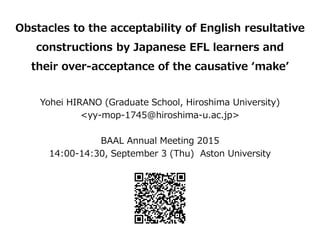


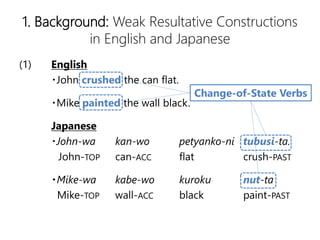



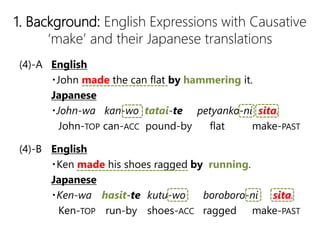

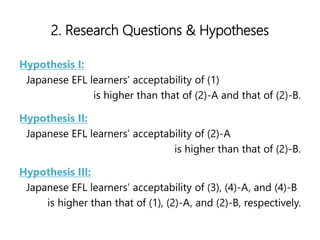


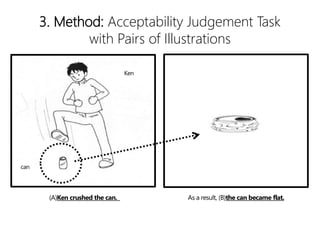
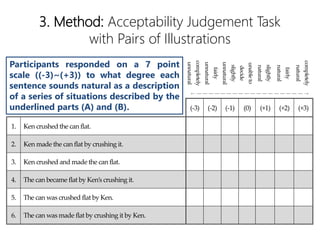
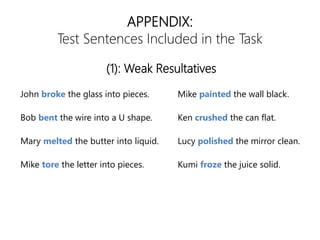
![APPENDIX:
Test Sentences Included in the Task
John hammered the can flat.
Paul kicked the door open.
John knocked Mike unconscious.
Tom shot the man dead.
Miki watered the tulips flat.
Mike shook his father awake.
The horse dragged the logs smooth.
The earthquake shook
the old house into pieces.
(2)-A: Strong Resultatives [Transitive]](https://image.slidesharecdn.com/baal2015-150830042841-lva1-app6892/85/BAAL2015-16-320.jpg)
![APPENDIX:
Test Sentences Included in the Task
Sam sang himself hoarse.
Ken ran himself tired.
Takashi ate himself sick.
Lucy danced herself sweaty.
Ken ran his shoes ragged.
Mike shouted his father awake.
Lucy danced her feet sore.
Tim drank the teapot empty.
(2)-B: Strong Resultatives [Intransitive]](https://image.slidesharecdn.com/baal2015-150830042841-lva1-app6892/85/BAAL2015-17-320.jpg)
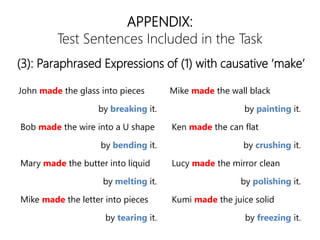



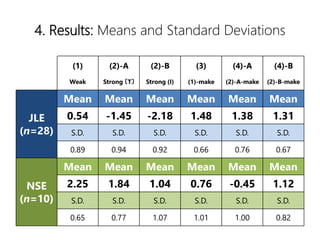
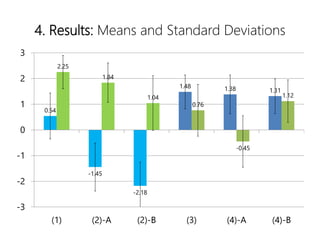
![5. Analysis: Two-way ANOVA Test
? One between-subject factor (Language)
[2 levels: Japanese?English]
? One within-subject factor (Sentence Type)
[6 levels: (1)?(2)-A?(2)-B?(3)?(4)-A?(4)-B]
?Significant Effect of Language:
F(1, 36) = 26.242, ĶĮ2 = .062, p<.001
?Significant Effect of Sentence Type:
F(2.09, 75.39) = 29.741, ĶĮ2 = .141, p<.001
?Significant Interaction
b/w Language and Sentence Type:
F(2.09, 75.39) = 60.55, ĶĮ2 = .287, p<.001](https://image.slidesharecdn.com/baal2015-150830042841-lva1-app6892/85/BAAL2015-24-320.jpg)
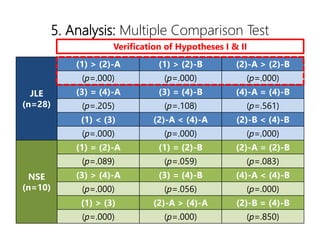
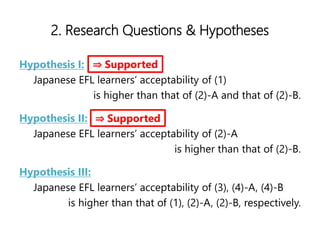
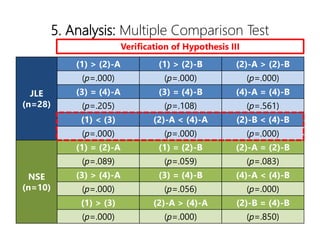
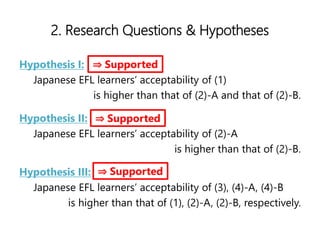
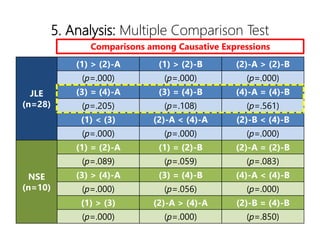

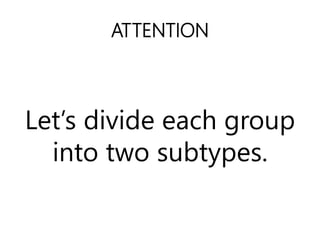
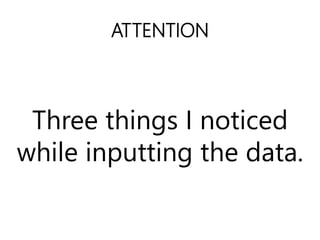

![APPENDIX:
Test Sentences Included in the Task
John hammered the can flat.
Paul kicked the door open.
John knocked Mike unconscious.
Tom shot the man dead.
Miki watered the tulips flat.
Mike shook his father awake.
The horse dragged the logs smooth.
The earthquake shook
the old house into pieces.
(2)-A Strong Resultatives [Transitive]
Verbs of Contact by Impact
ĒÛ ST-I ĒÜ ST-O](https://image.slidesharecdn.com/baal2015-150830042841-lva1-app6892/85/BAAL2015-34-320.jpg)
![APPENDIX:
Test Sentences Included in the Task
Sam sang himself hoarse.
Ken ran himself tired.
Takashi ate himself sick.
Lucy danced herself sweaty.
Ken ran his shoes ragged.
Mike shouted his father awake.
Lucy danced her feet sore.
Tim drank the teapot empty.
(2)-B Strong Resultatives [Intransitive]
Reflexives
ĒÝ SI-R
Fake-objects
ĒÞ SI-F](https://image.slidesharecdn.com/baal2015-150830042841-lva1-app6892/85/BAAL2015-35-320.jpg)
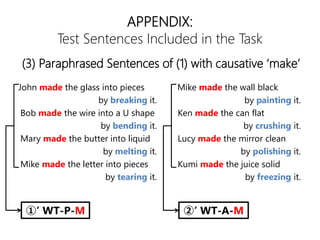

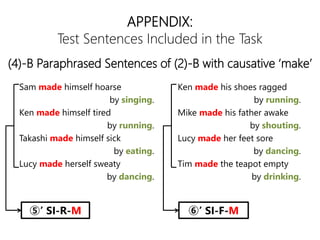
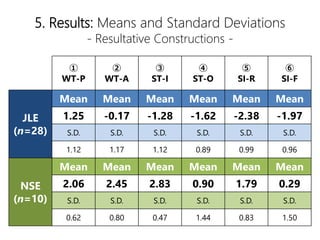
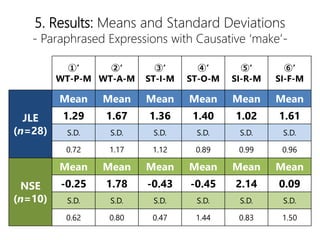

![5. Analysis: Two-way ANOVA Test
? One between-subject factor (Language)
[2 levels: Japanese?English]
? One within-subject factor (Sentence Type)
[6 levels: ĒŲ?ĒÚ?ĒÛ?ĒÜ?ĒÝ?ĒÞ]
?Significant Effect of Language:
F(1, 36) = 189.124, ĶĮ2 = .038, p<.001
?Significant Effect of Sentence Type:
F(3.61, 130) = 30.001, ĶĮ2 = .164, p<.001
?Significant Interaction
b/w Language and Sentence Type:
F(3.61, 130) = 12.268, ĶĮ2 = .067, p<.001](https://image.slidesharecdn.com/baal2015-150830042841-lva1-app6892/85/BAAL2015-42-320.jpg)
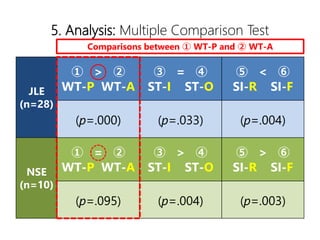

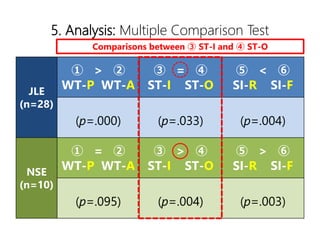
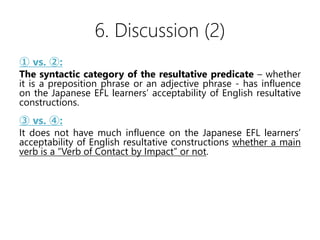
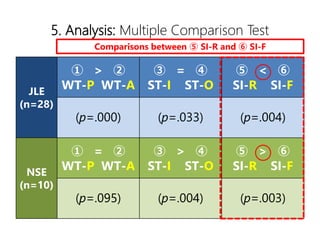
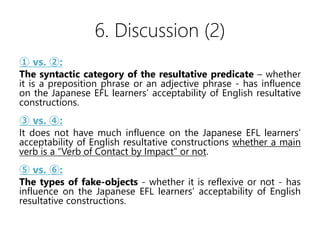
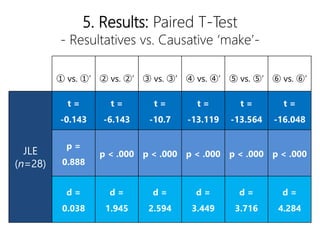
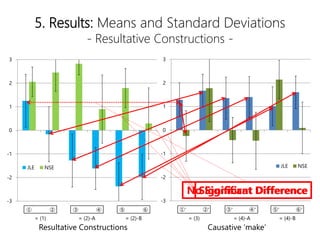
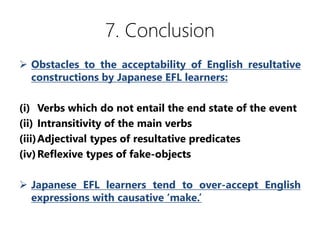

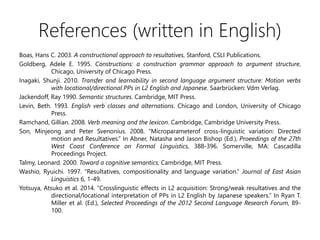
![References (written in Japanese)
Ando, Sadao. 2005 Gendai Eibunpou Kougi [Lectures on Modern English Grammar], Kaitakusha, Tokyo.
Kageyama, Taro. 1996. Doosi-Imiron [Verb Semantics], Kurosio, Tokyo.
Kageyama, Taro. 2001. Ą°Kekka-Koubun [Resultative Construction]Ąą Kageyama Taro (ed.) Nichiei-Taishou
Doosi-no Imi-to Koubun [Meaning and Construction of Verbs], 154-181, Taishukan, Tokyo.
Ono, Naoyuki. 2005. Seisei Goi Imiron [Generative Lexical Semantics], Hitsuji-shobo, Tokyo.
Ono, Naoyuki (ed). 2007. Kekka-Koubun-no Sin-siten [New Perspectives on Resultative Constructions],
Hitsuji-shobo, Tokyo.
Ono, Naoyuki (ed). 2009. Kekka-Koubun-no Taiporojii [Typologies on Resultative Constructions], Hitsuji-
shobo, Tokyo.
Ono, Naoyuki 2012a. Ą°Sateraito-fureimu Genngo-to Doosi-fureimu Gengo [Satillete-framed Languages
and Verb-framed Languages]Ąą Fujita Koji et al. (ed.) Saisin Gengo Riron-wo Eigo Kyouiku-ni
Katsuyou Suru [Exploitation of the Latest Linguistic Theories in English Eucation], Kaitakusha,
Tokyo.
Ono, Naoyuki 2012b. Ą°Kekka-Koubun-no Imiron [Semantics of Resultative Constructions]Ąą Sawada
Harumi (ed.) Koubun-to Imi [Constructions and Meanings], 89-106, Hitsuji-shobo, Tokyo.](https://image.slidesharecdn.com/baal2015-150830042841-lva1-app6892/85/BAAL2015-54-320.jpg)
